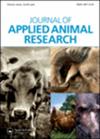了解本地山羊的类型和功能:对遗传改良和保护方案的投入
IF 1.3
4区 农林科学
Q3 AGRICULTURE, DAIRY & ANIMAL SCIENCE
引用次数: 0
摘要
本文章由计算机程序翻译,如有差异,请以英文原文为准。
Towards understanding the type and function of indigenous goats: input for genetic improvement and conservation programme
ABSTRACT This study aimed to provide a better understanding of the type, function, and production potential of Central Highland goats. Morphometric measurements were collected from 510 heads of goats. About 17 biologically important structural indices were computed using morphological trait measurements. The data were analyzed using SAS’s general linear model, principal component analysis, and stepwise multiple regression techniques. Body index value indicate that the Central Highland goat’s shape is rectangular, which is good conformation for meat production. The dactyl thorax, transverse pelvic, longitudinal pelvic, relative depth of thorax, and width indices suggest their suitability for meat production. However, proportionality and length indices showed an aptitude for milk production. Besides, the body ratio and depth indices indicate less susceptibility of this goat breed to dust infestation and arthritis, good walking ability, good foraging capability, and move easily in sloppy areas. In conclusion, structural indices showed that Central Highland goats could be classified as having a dual purpose and better aptitude for meat production. The results of this study could be an input for designing genetic improvement and conservation programmes for the sustainable utilization of indigenous goats.
求助全文
通过发布文献求助,成功后即可免费获取论文全文。
去求助
来源期刊

Journal of Applied Animal Research
农林科学-奶制品与动物科学
CiteScore
2.70
自引率
0.00%
发文量
80
审稿时长
6 months
期刊介绍:
Journal of Applied Animal Research (JAAR) is an international open access journal. JAAR publishes articles related to animal production and fundamental aspects of genetics, nutrition, physiology, reproduction, immunology, pathology and animal products. Papers on cows and dairy cattle, small ruminants, horses, pigs and companion animals are very welcome, as well as research involving other farm animals, aquatic and wildlife species. In addition, manuscripts involving research in other species that is directly related to animal production will be considered for publication.
 求助内容:
求助内容: 应助结果提醒方式:
应助结果提醒方式:


